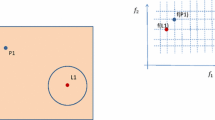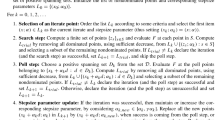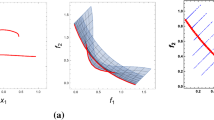Abstract
Polynomial interpolation or regression models are an important tool in Derivative-free Optimization, acting as surrogates of the real function. In this work, we propose the use of these models in the multiobjective framework of directional direct search, namely the one of Direct Multisearch. Previously evaluated points are used to build quadratic polynomial models, which are minimized in an attempt of generating nondominated points of the true function, defining a search step for the algorithm. Numerical results state the competitiveness of the proposed approach.








Similar content being viewed by others
References
Afshari, H., Hare, W., Tesfamariam, S.: Constrained multi-objective optimization algorithms: review and comparison with application in reinforced concrete structures. Appl. Soft Comput. 83, 105631 (2019)
Akhtar, T., Shoemaker, C.A.: Multi objective optimization of computationally expensive multi-modal functions with RBF surrogates and multi-rule selection. J. Glob. Optim. 64, 17–32 (2016)
Audet, C., Hare, W.: Derivative-Free and Blackbox Optimization. Springer, Cham (2017)
Audet, C., Dennis Jr., J.E.: Analysis of generalized pattern search. SIAM J. Optim. 13, 889–903 (2003)
Audet, C., Dennis Jr., J.E.: Mesh adaptive direct search algorithms for constrained optimization. SIAM J. Optim. 17, 188–217 (2006)
Audet, C., Savard, G., Zghal, W.: Multiobjective optimization through a series of single-objective formulations. SIAM J. Optim. 19, 188–210 (2008)
Branke, J., Deb, K., Miettinen, K., Slowiński, R. (eds.): Multiobjective Optimization: Interactive and Evolutionary Approaches. Springer, Berlin (2008)
Brito, R.P., Sebastião, H., Godinho, P.: Efficient skewness/semivariance portfolios. J. Asset Manag. 17, 331–346 (2016)
Brito, R.P., Sebastião, H., Godinho, P.: Portfolio management with higher moments: the cardinality impact. Int. Trans. Oper. Res. 26, 2531–2560 (2019)
Burachik, R.S., Kaya, C.Y., Rizvi, M.M.: A new scalarization technique and new algorithms to generate Pareto fronts. SIAM J. Optim. 27, 1010–1034 (2017)
Chan, T.M.: Klee’s measure problem made easy. In: IEEE 54th Annual Symposium on Foundations of Computer Science, Vol. 2013, pp. 410–419. IEEE (2013)
Clarke, F.H.: Optimization and Nonsmooth Analysis. SIAM, Philadelphia (1990)
Cocchi, G., Liuzzi, G., Papini, A., Sciandrone, M.: An implicit filtering algorithm for derivative-free multiobjective optimization with box constraints. Comput. Optim. Appl. 69, 267–296 (2018)
Conn, A.R., Le Digabel, S.: Use of quadratic models with mesh-adaptive direct search for constrained black box optimization. Optim. Methods Softw. 28, 139–158 (2013)
Conn, A.R., Scheinberg, K., Vicente, L.N.: Introduction to Derivative-Free Optimization, MPS-SIAM Series on Optimization. SIAM, Philadelphia (2009)
Custódio, A.L., Madeira, J.F.A.: MultiGLODS: global and local multiobjective optimization using direct search. J. Glob. Optim. 72, 323–345 (2018)
Custódio, A.L., Madeira, J.F.A., Vaz, A.I.F., Vicente, L.N.: Direct multisearch for multiobjective optimization. SIAM J. Optim. 21, 1109–1140 (2011)
Custódio, A.L., Rocha, H., Vicente, L.N.: Incorporating minimum Frobenius norm models in direct search. Comput. Optim. Appl. 46, 265–278 (2010)
Datta, R., Regis, R.G.: A surrogate-assisted evolution strategy for constrained multi-objective optimization. Exp. Syst. Appl. 57, 270–284 (2016)
Davis, C.: Theory of positive linear dependence. Am. J. Math. 76, 733–746 (1954)
Deb, K., Pratap, A., Agarwal, S., Meyarivan, T.: A fast and elitist multiobjective genetic algorithm: NSGA-II. IEEE Trans. Evol. Comput. 6, 182–197 (2002)
Deshpande, S., Watson, L.T., Canfield, R.A.: Pareto front approximation using a hybrid approach. Procedia Comput. Sci. 18, 521–530 (2013)
Deshpande, S., Watson, L.T., Canfield, R.A.: Multiobjective optimization using an adaptive weighting scheme. Optim. Methods Softw. 31, 110–133 (2016)
Dolan, E.D., Moré, J.J.: Benchmarking optimization software with performance profiles. Math. Program. 91, 201–213 (2002)
Feliot, P., Bect, J., Vazquez, E.: A Bayesian approach to constrained single and multi-objective optimization. J. Glob. Optim. 26, 97–133 (2017)
Fliege, J., Vaz, A.I.F.: A method for constrained multiobjective optimization based on SQP techniques. SIAM J. Optim. 26, 2091–2119 (2016)
Fonseca, C.M., Paquete, L., López-Ibánez, M.: An improved dimension-sweep algorithm for the hypervolume indicator. In: Proceedings of the 2006 Congress on Evolutionary Computation (CEC’06), IEEE, pp. 1157–1163 (2006)
Handl, J., Kell, D.B., Knowles, J.: Multiobjective optimization in bioinformatics and computational biology. IEEE-ACM Trans. Comput. Bioinform. 4, 279–292 (2007)
Hirpa, D., Hare, W., Lucet, Y., Pushak, Y., Tesfamariam, S.: A bi-objective optimization framework for three-dimensional road alignment design. Transp. Res. Part C Emerging Technol. 65, 61–78 (2016)
Jahn, J.: Introduction to the Theory of Nonlinear Optimization. Springer, Berlin (1996)
Kolda, T.G., Lewis, R.M., Torczon, V.: Optimization by direct search: new perspectives on some classical and modern methods. SIAM Rev. 45, 385–482 (2003)
Lacour, R., Klamroth, K., Fonseca, C.M.: A box decomposition algorithm to compute the hypervolume indicator. Comput. Oper. Res. 79, 347–360 (2017)
Liuzzi, G., Lucidi, S., Rinaldi, F.: A derivative-free approach to constrained multiobjective nonsmooth optimization. SIAM J. Optim. 26, 2744–2774 (2016)
Miettinen, K.: Nonlinear Multiobjective Optimization. International Series in Operations Research and Management Science. Springer, New York (1998)
Potrebko, P.S., Fiege, J., Biagioli, M., Poleszczuk, J.: Investigating multi-objective fluence and beam orientation IMRT optimization. Phys. Med. Biol. 62, 5228–5244 (2017)
Powell, M.J.D.: Developments of NEWUOA for minimization without derivatives. IMA J. Numer. Anal. 28, 649–664 (2008)
Rangaiah, G.P., Bonilla-Petriciolet, A. (eds.): Multi-objective Optimization in Chemical Engineering: Developments and Applications. Wiley, Chichester (2013)
Regis, R.G.: Multi-objective constrained black-box optimization using radial basis function surrogates. J. Comput. Sci. 16, 140–155 (2016)
Ryu, J.-H., Kim, S.: A derivative-free trust-region method for biobjective optimization. SIAM J. Optim. 24, 334–362 (2014)
Thacker, W.I., Zhang, J., Watson, L.T., Birch, J.B., Iyer, M.A., Berry, M.W.: Algorithm 905: SHEPPACK: modified Shepard algorithm for interpolation of scattered multivariate data. ACM Trans. Math. Softw. 37, 1–20 (2010)
Thomann, J., Eichfelder, G.: A trust-region algorithm for heterogeneous multiobjective optimization. SIAM J. Optim. 29, 1017–1047 (2019)
Wiecek, M.M., Ehrgott, M., Engau, A.: Multiple Criteria Decision Analysis. Continuous Multiobjective Programming, pp. 739–815. Springer, New York (2016)
Zitzler, E., Thiele, L.: Multiobjective optimization using evolutionary algorithms—a comparative case study. In: Eiben, A.E., Bäck, T., Schoenauer, M., Schwefel, H.-P. (eds.) Parallel Problem Solving from Nature—PPSN V: 5th International Conference Amesterdam, The Netherlands, pp. 292–301. Springer, Berlin, Heidelberg, Germany (1998)
Zitzler, E., Thiele, L., Laumanns, M., Fonseca, C.M., Grunert da Fonseca, V.: Performance assessment of multiobjective optimizers: an analysis and review. IEEE Trans. Evol. Comput. 7, 117–132 (2003)
Acknowledgements
The authors would like to thank the two anonymous referees, whose comments and suggestions improved the quality of the paper.
Funding
Support for both authors was provided by national funds through FCT – Fundação para a Ciência e a Tecnologia I. P., under the scope of Projects PTDC/MAT-APL/28400/2017 and UIDB/00297/2020.
Author information
Authors and Affiliations
Corresponding author
Additional information
Publisher's Note
Springer Nature remains neutral with regard to jurisdictional claims in published maps and institutional affiliations.
Rights and permissions
About this article
Cite this article
Brás, C.P., Custódio, A.L. On the use of polynomial models in multiobjective directional direct search. Comput Optim Appl 77, 897–918 (2020). https://doi.org/10.1007/s10589-020-00233-8
Received:
Accepted:
Published:
Issue Date:
DOI: https://doi.org/10.1007/s10589-020-00233-8
Keywords
- Multiobjective optimization
- Derivative-free optimization
- Direct search methods
- Quadratic polynomial interpolation and regression
- Minimum Frobenius norm models




